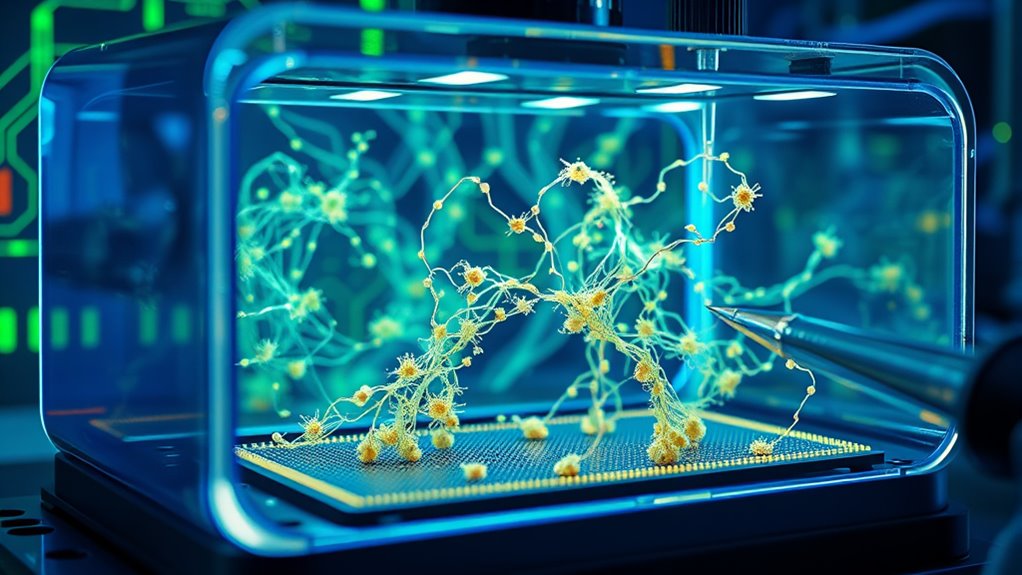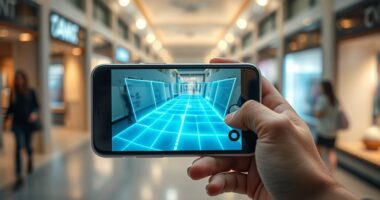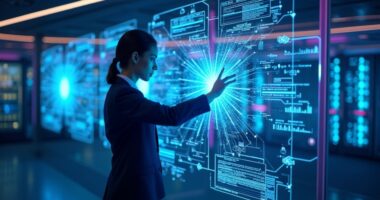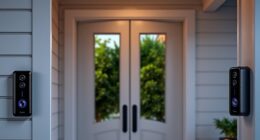Bio‑computers use living cells and biological molecules like DNA and enzymes to process data in new ways. Instead of electrical signals, they rely on chemical reactions and biological interactions to perform calculations and make decisions. By designing DNA sequences and engineering enzymes, you can create biological logic gates that control processes within cells. Keep exploring how these innovative systems work, and you’ll discover even more fascinating insights into this cutting-edge technology.
Key Takeaways
- Bio-computers utilize living cells and biological molecules like DNA and enzymes to perform data processing tasks.
- Enzymes act as biological logic gates, controlling gene expression and enabling complex computations within cells.
- Synthetic biology allows designing genetic circuits that mimic traditional computing functions at the molecular level.
- Advances in nanobiotechnology enable engineering of biological components for sophisticated, scalable bio-computing systems.
- Potential applications include medical diagnostics, environmental monitoring, and advanced biological data storage.

Have you ever wondered how living cells can perform complex computations? The answer lies in the fascinating field of bio-computers, which use living cells or biologically derived molecules like DNA, RNA, and proteins to process data. Unlike traditional computers that rely on electrical signals, bio-computers operate through chemical inputs and biological interactions. At their core, DNA acts as an information storage “tape,” with four nucleotide bases—adenine (A), cytosine (C), guanine (G), and thymine (T)—encoding instructions similar to digital data. These sequences can be designed and edited to perform specific functions, effectively turning DNA into a biological version of a computer program.
Within living cells, enzymes such as polymerases and helicases read, copy, and manipulate DNA to carry out computational tasks. They act like logic gates or switches, controlling gene expression or recording exposure to stimuli based on the chemical signals they encounter. These biological transistors, sometimes called “transcriptors,” enable logical operations inside cells by controlling the activity of specific genes. Instead of electrons flowing through silicon, these molecular components use chemical reactions to perform calculations, making bio-computers uniquely suited for tasks that involve complex biological processes. Furthermore, advances in synthetic biology have enabled scientists to design customized genetic elements that expand the computational capabilities of bio-systems.
Enzymes like polymerases and helicases act as biological logic gates, controlling gene activity through chemical reactions.
Recent advances in nanobiotechnology have propelled bio-computers forward. Scientists can now engineer biomolecules at the nanoscale to build functional computational structures within cells. By designing genetic circuits composed of DNA and RNA, they can create logic functions similar to those in silicon transistors. Programming these systems involves editing DNA sequences to influence enzyme behavior and cellular responses, allowing for the construction of increasingly sophisticated biological logic gates. These emergent properties arise from interactions among molecular components, giving living cells the ability to execute complex functions that go beyond simple reactions. Moreover, researchers are exploring ways to enhance the reliability and scalability of these systems to make them more practical for real-world applications.
Frequently Asked Questions
How Do Bio-Computers Compare to Traditional Silicon-Based Computers in Speed?
You might wonder how bio-computers compare to traditional silicon computers in speed. While silicon devices switch signals in nanoseconds, bio-computers operate slower, often taking milliseconds or seconds per operation. However, bio-computers excel through massive parallel processing, handling many tasks simultaneously. Although they’re not as fast individually, their ability to process large data sets in parallel could lead to faster overall performance in specific applications.
What Are the Main Ethical Concerns Surrounding Bio-Computer Technology?
You’re concerned about the main ethical issues with bio-computer technology. You realize that if these systems gain consciousness, they might deserve moral rights, raising questions about their treatment. You’re also aware of privacy risks involving biological data and the challenge of protecting sensitive information. Additionally, you see biosafety concerns, like environmental impacts and potential contamination, and social issues, such as inequality and acceptance of new human-machine integrations.
Can Bio-Computers Be Integrated With Existing Electronic Systems?
Did you know that advanced microelectrode arrays can map 70,000 neural connections? Regarding your question, yes, bio-computers can be integrated with existing electronic systems. You’ll find that combining living cells with electronics creates hybrid networks capable of two-way communication, enabling real-time monitoring and control. Although challenges like maintaining cell health and signal reliability exist, ongoing innovations make seamless integration increasingly feasible for practical applications.
What Types of Living Cells Are Used in Bio-Computers?
You might wonder what types of living cells are used in bio-computers. Bacteria like *Escherichia coli* are common because they’re simple, easy to manipulate, and reproduce quickly, making them ideal for genetic circuits. Human cells are also used, especially in neural networks, to create more advanced, adaptable bio-computers. Both types enable biological systems to process information, perform logic, and respond dynamically to their environment.
How Long Do Bio-Computer Components Typically Function Before Needing Replacement?
Think of bio-computer components as delicate flowers that need care. You’ll find that human brain organoids last about 100 days, though this is improving. Lab-grown neurons typically function up to six months before needing replacement. So, if you’re building or maintaining one, be prepared for regular updates. Their limited lifespan remains a hurdle, but ongoing research aims to extend their durability, making biocomputers more practical over time.
Conclusion
You might wonder if bio-computers could really replace traditional tech someday. While they harness living cells for innovative data processing, challenges like stability and control remain. But considering how nature constantly adapts, it’s believable that someday, these biological systems could revolutionize computing. If life already solves complex problems daily, why not tap into its power? So, embracing bio-computers might just be the next step in pushing technology beyond what we thought possible.








